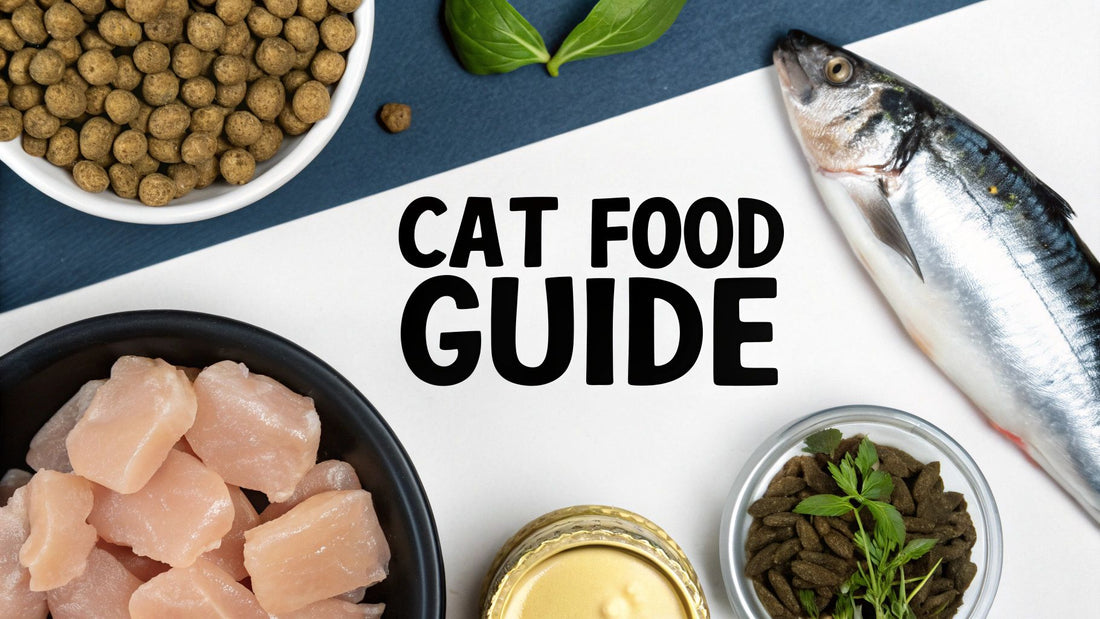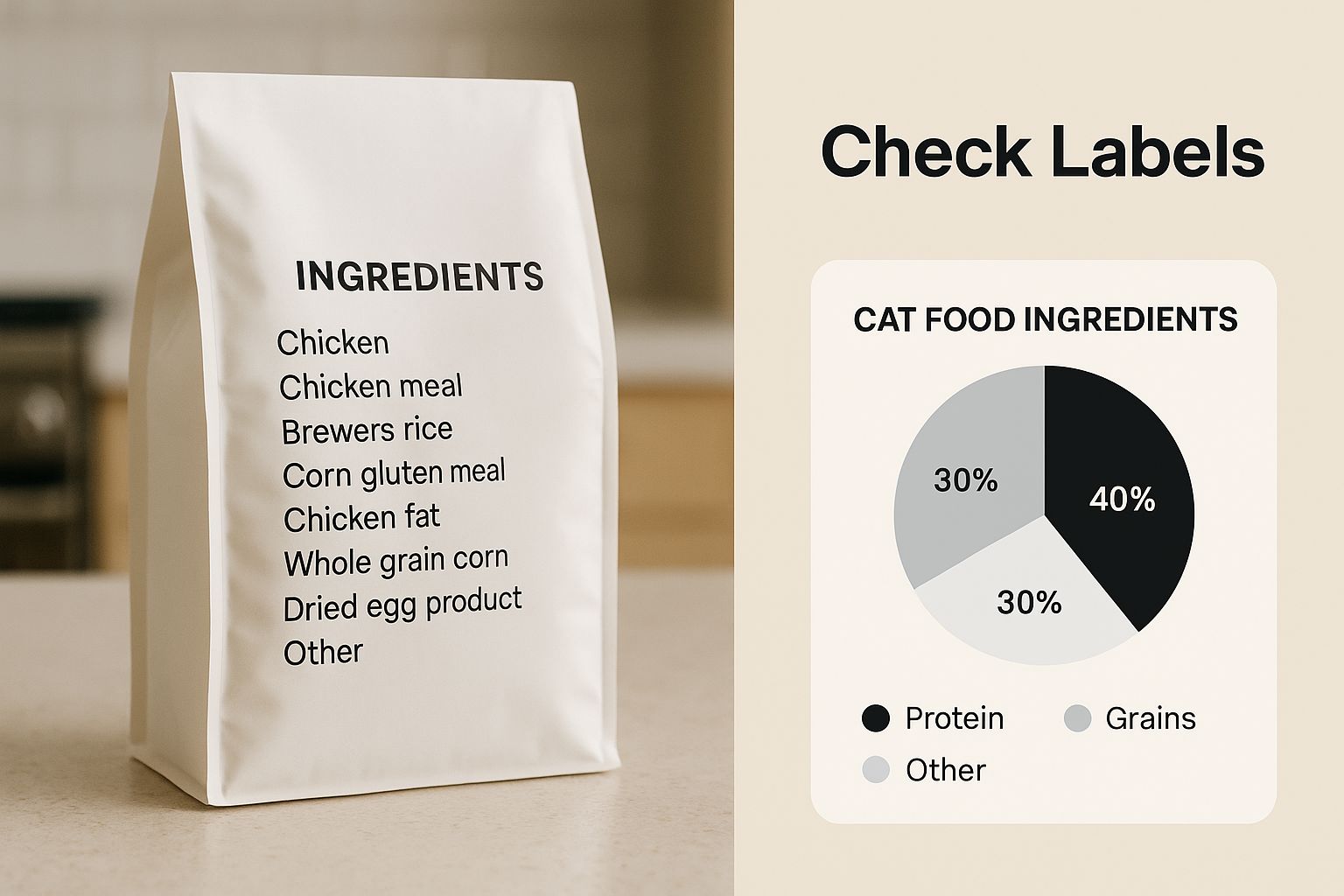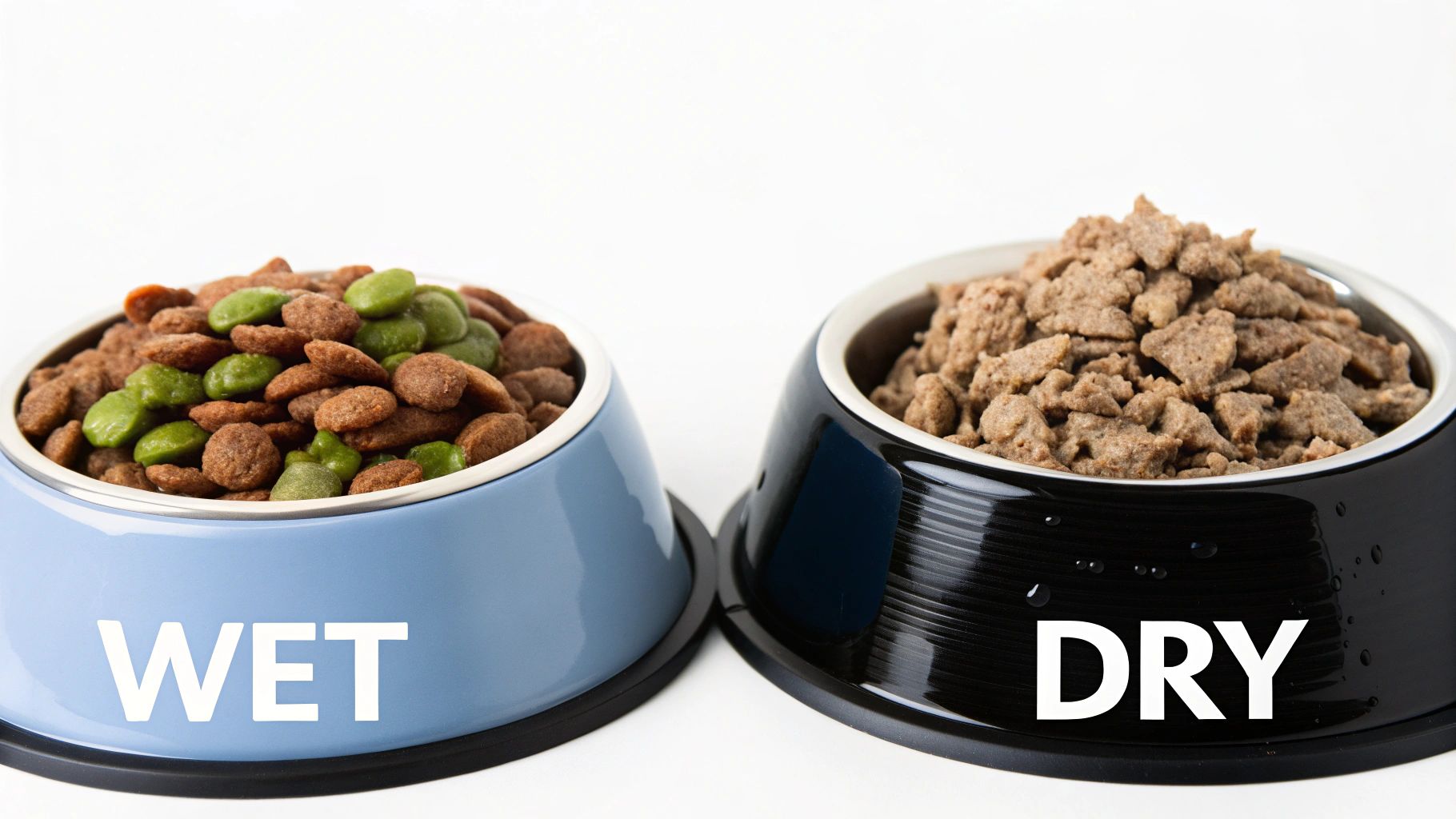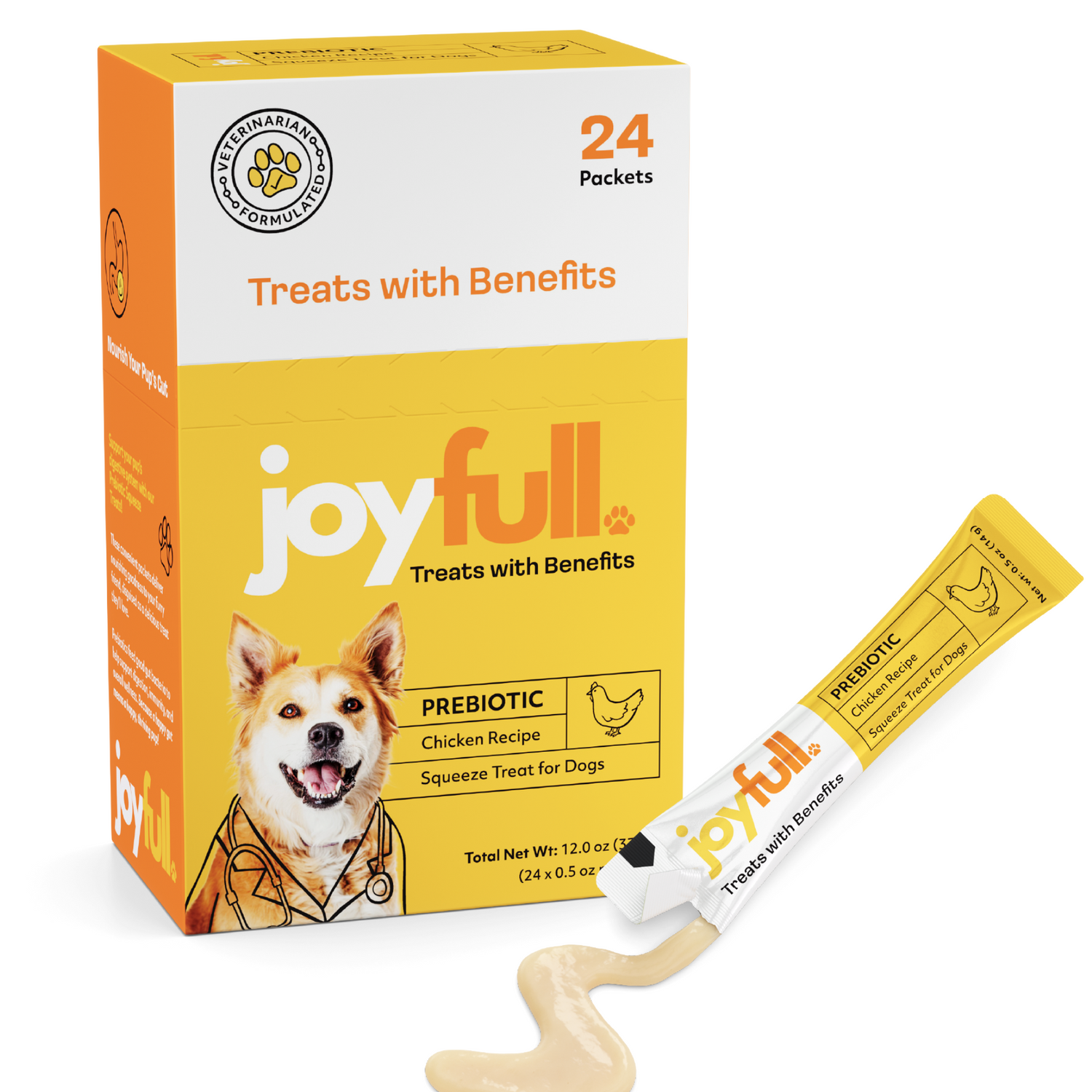
What to Look for in Cat Food A Guide
When you're standing in the pet food aisle, trying to figure out what to buy, it all boils down to a few simple things: your cat needs high-quality, animal-based protein, plenty of moisture, and a formula that's nutritionally complete. It's about feeding them in a way that respects their inner hunter. Honestly, getting their food right is one of the biggest things you can do for their health and happiness down the road.
Why Your Cat's Food Matters More Than You Think
Let's be real: choosing the right cat food can be completely overwhelming. You're faced with a wall of bags and cans, all covered in pictures of gorgeous, happy cats and plastered with words like "grain-free," "natural," and "holistic." But what does any of that marketing fluff actually mean for your cat? The reality is, what you put in their bowl has a direct impact on everything—from how shiny their coat is to their energy levels, and even how long they live.
To make sense of it all, you need to grasp one crucial fact about your cat: they are obligate carnivores.
That isn't just some scientific jargon; it's the biological blueprint for their entire diet. Unlike dogs or people, who can get nutrients from all sorts of foods, cats evolved to thrive almost exclusively on meat. Just picture a tiny, highly efficient predator, perfectly adapted over thousands of years to a carnivorous lifestyle.
This single principle tells us exactly what we need to look for in their food:
- High-Quality Animal Protein: This is the absolute cornerstone. Cats need certain amino acids, like taurine, that are only found in meaningful amounts in animal tissue. They simply can't get them from plants.
- Plenty of Moisture: Out in the wild, cats get most of their water from the prey they eat. Our house cats still have that same low thirst drive, which makes moisture-rich food essential for keeping their kidneys and urinary tract healthy.
- The Right Nutrients: A properly balanced food gives them the perfect mix of fats, vitamins, and minerals to keep everything from their immune system to their eyesight in top shape.
The Modern Pet Food Landscape
The pet food industry has definitely caught on to how much we care about our cats' nutrition. As we've all become more informed, the demand for premium, specialized diets has exploded. The global cat food market was valued at around USD 66.6 billion in 2025, a number that’s shot up thanks to the popularity of organic, grain-free, and custom-tailored foods. You can dig into more insights about the pet food products market on towardsfnb.com and see just how our choices are changing the industry.
This growth is a bit of a mixed blessing. On one hand, we have more high-quality options than ever. On the other, it just adds to the confusion. Knowing what your cat actually needs is your best defense against clever marketing.
That's what this guide is all about—giving you that knowledge. We're going to walk through how to read a pet food label like an expert, spot the ingredients that matter, and steer clear of cheap fillers. By the end, you'll feel confident that every meal you serve is helping your cat live a long, vibrant, and healthy life.
How to Decode the Cat Food Label
Walking down the pet food aisle can feel overwhelming. The packaging is a dizzying mix of percentages, marketing claims, and scientific-sounding terms. It’s easy to feel lost.
But learning to read that label is the single most important skill you can have as a cat owner. Think of it less as an advertisement and more as a nutritional cheat sheet—you just need to know the code.
Let’s break down the most important parts of the label so you can feel confident in your choices.

As you can see, the real story is often in the fine print.
Understanding the Guaranteed Analysis
Every bag or can has a box of numbers called the Guaranteed Analysis. This lists the minimum percentages of crude protein and fat, and the maximum percentages of crude fiber and moisture. Don't get hung up on the word "crude"—it just refers to the scientific method used to measure the nutrients, not their quality.
Here’s the catch: these numbers can be incredibly misleading, especially when comparing wet and dry food. A can of wet food with 10% protein might look inferior to a bag of kibble with 35% protein, but that's not the full picture.
The huge difference in moisture content skews the numbers. To make a fair comparison, you need to look at the nutrients on a dry matter basis, which basically means calculating the nutrient levels after all the water has been removed.
It’s like comparing the strength of two cups of coffee. One is a huge, watered-down Americano, and the other is a tiny, concentrated espresso. You can't judge the caffeine kick by the size of the cup alone; you have to figure out the concentration.
The Dry Matter Basis Calculation
Doing the math yourself is easier than it sounds. First, find the moisture percentage on the label and subtract it from 100%. That number is your total dry matter.
Then, just divide the protein percentage listed on the label (the "as fed" value) by your dry matter percentage. Let’s run the numbers from our example:
-
Wet Food: 78% moisture, 12% crude protein.
- Dry Matter = 100% - 78% = 22%
- Protein on Dry Matter Basis = (12% ÷ 22%) x 100 = 54.5%
-
Dry Food: 10% moisture, 35% crude protein.
- Dry Matter = 100% - 10% = 90%
- Protein on Dry Matter Basis = (35% ÷ 90%) x 100 = 38.9%
Just like that, the wet food is revealed to be much higher in protein. This one simple calculation changes everything.
To see this in action, check out how the numbers shift for all the key nutrients when we convert them.
Comparing Wet Vs Dry Food On A Dry Matter Basis
This table illustrates how to convert the 'Guaranteed Analysis' percentages from a wet food and a dry food label to a dry matter basis, revealing the true nutrient levels for an accurate comparison.
| Nutrient | Wet Food (As Fed) | Wet Food (Dry Matter) | Dry Food (As Fed) | Dry Food (Dry Matter) |
|---|---|---|---|---|
| Crude Protein (min) | 12.0% | 54.5% | 35.0% | 38.9% |
| Crude Fat (min) | 6.0% | 27.3% | 20.0% | 22.2% |
| Crude Fiber (max) | 1.0% | 4.5% | 4.0% | 4.4% |
| Moisture (max) | 78.0% | - | 10.0% | - |
As you can see, the initial "as fed" numbers on the label don't tell the whole story. Converting to a dry matter basis gives you the real insight you need to choose the right food for your cat.
Cracking the AAFCO Code
Look closely on the label, usually somewhere beneath the Guaranteed Analysis, and you'll find a small but vital statement from The Association of American Feed Control Officials (AAFCO). AAFCO sets the nutritional standards for pet food in the United States.
Think of an AAFCO statement as a pass/fail grade. It’s the brand's way of saying, "We followed the rules and our recipe meets the minimum nutritional requirements for cats." It doesn’t mean the food is high-quality, but it does mean it’s nutritionally complete.
You'll usually see one of two phrases:
- "Formulated to meet the nutritional levels established by the AAFCO Cat Food Nutrient Profiles for..." This means the recipe was designed in a lab to meet the standards on paper. It's good, but there's a better option.
- "Animal feeding tests using AAFCO procedures substantiate that [Product Name] provides complete and balanced nutrition for..." This is widely considered the gold standard. It means the food was actually fed to cats in a controlled trial to prove they could digest it properly and thrive on it.
The statement will also specify a life stage, like "adult maintenance" or "growth and reproduction." Make sure this matches your cat’s needs. If a food has no AAFCO statement at all, it should only be used as a treat or topper, not as a primary diet.
Decoding Protein: What Your Carnivore Craves
When you flip over a bag of cat food, the first thing your eyes should jump to is the ingredient list.Why? Because the most important nutrient for your cat is right there at the top: protein. Cats are what's known as obligate carnivores, which is a scientific way of saying their bodies are built, from tooth to tail, to thrive on meat.
Think of it like this: you wouldn't put diesel in a Ferrari. A cat's body is a finely-tuned machine designed to run on high-quality, animal-based fuel. This isn't just a preference; it's a biological necessity that powers everything from their playful pounces to their immune system.
This is also why certain amino acids, the building blocks of protein, are absolutely critical. You've probably heard of taurine. Cats can't make it themselves, so they have to get it from their diet. A lack of taurine can cause devastating health problems, including blindness and heart failure. Where is taurine found? In abundance in animal muscle tissue, and it's practically nonexistent in plants.
Reading an Ingredient List Like an Expert
The ingredient list is your window into the real quality of the food. It's arranged by weight, so whatever you see listed first, second, and third makes up the majority of what's in that bag or can. When you're trying to figure out what to look for in cat food, you want to see specific, named animal proteins leading the charge.
So, what exactly is a "named animal protein"? It’s simple and transparent.
- Top-Tier Proteins: Look for words like "deboned chicken," "turkey," "salmon," or "beef." These are the real deal—whole meat sources you can easily identify.
- Great Protein Concentrates: Seeing "chicken meal" or "turkey meal" is also a good sign. A "meal" isn't a lesser ingredient; it's simply meat with the water and fat removed, creating a highly concentrated and digestible protein powder.
- Proceed with Caution: Vague terms like "meat by-products" or "poultry by-products" can be a mixed bag. While they might include nutrient-rich organ meats, they can also contain less desirable parts like feet or intestines. The lack of transparency is the main issue here.
Specificity is everything. "Chicken" tells you precisely what your cat is eating. "Meat"? That’s a mystery protein from an unknown animal source. Always aim for clarity.
The Problem with Plant Proteins
It's common to see ingredients like "pea protein," "corn gluten meal," or "soy" high up on the list. These are often used to pump up the protein percentage you see on the "Guaranteed Analysis" panel, but they're a poor substitute for the real thing.
A cat’s digestive tract is short and acidic—perfectly engineered to efficiently process meat. It simply isn't designed to handle a heavy load of plant material. More importantly, plant proteins don't have the complete amino acid profile a cat needs, especially critical ones like taurine and arginine.
Your cat's entire well-being is linked to the biological value of the protein they eat. Animal protein delivers the complete toolkit of essential nutrients that plant sources just can't provide. It’s the cornerstone of a healthy feline diet, and it's non-negotiable.
Choosing a food that respects your cat’s carnivorous nature is the single most important decision you can make for them. Industry data for 2025 showed that animal-derived proteins like chicken and fish accounted for around 22.7% of protein sources in cat food, and you can discover more insights about cat food market trends on futuremarketinsights.com.
Ultimately, by prioritizing high-quality, identifiable animal proteins, you’re giving your cat the fundamental nutrition they were evolved to eat. For an even deeper look, explore our guide on the best ingredients for cat food. This one simple habit of checking the ingredients first is the most powerful step you can take toward a long and vibrant life for your furry friend.
What To Watch Out For: Carbs and Fillers
Sometimes, what’s not in your cat's food is just as critical as what is. We’ve talked a lot about finding high-quality animal protein, but now it’s time to flip the script and look at the other stuff in the bag—specifically, carbohydrates and fillers.
Cats are obligate carnivores, which is a scientific way of saying their bodies are built to run on meat. In the wild, the only carbs they'd eat would be the tiny amount found in their prey's stomach. While they can digest some carbohydrates, a diet loaded with them can lead to weight gain and other health problems down the road.
That said, not all carbs are villains. Small amounts of complex carbs from sources like sweet potatoes, pumpkin, or peas can offer a quick energy boost and some valuable dietary fiber. The real trick is learning to spot the cheap, low-quality fillers that are just taking up space.
Spotting Low-Quality Fillers
Think of fillers as cheap bulking agents. They add volume and help form kibble, but they don't add much nutritional value. A food that leads with these ingredients is often cutting corners on quality to save money.
These ingredients are notorious for offering little more than empty calories and can even trigger digestive upset or food sensitivities in some cats.
Keep an eye out for these common offenders on the ingredient list:
- Corn and Corn Gluten Meal: This is a classic filler. It's often used to artificially inflate the protein percentage on the label, but plant-based protein isn't what your little carnivore needs.
- Wheat and Wheat Gluten: A common allergen for many cats, wheat is mostly just empty carbs.
- Soy and Soy Products: Another plant-based protein booster that can be tough for some cats to digest properly.
The shift toward higher-quality pet food has led to a boom in grain-free and limited-ingredient diets, which were created to solve this very problem. Smart cat owners now know to scan the ingredient panel for red flags like corn and wheat, ensuring the focus stays on high-quality nutrition. You can see just how much this matters to consumers in these pet food statistics and consumer trends on market.us.
The Good Extras: Functional Ingredients
While you're on the lookout for bad fillers, you should also be searching for the good stuff—the beneficial extras that turn an average food into a truly great one. These are called functional ingredients, and they actively support your cat's overall health.
Think of it like building a house. High-quality protein is the strong foundation and frame. Low-quality fillers are like using cheap drywall that adds no structural integrity. Functional ingredients are the high-performance windows and insulation that make the whole structure better.
For a deeper dive into this, our guide on ingredients to avoid in cat food is a great resource for telling the good from the bad.
Here are some of the best functional ingredients to look for:
- Omega Fatty Acids: Found in fish oil (salmon oil is fantastic) and flaxseed, these healthy fats are key for healthy skin, a shiny coat, and reducing inflammation.
- Antioxidants: Ingredients like blueberries, cranberries, and vitamins E and C help protect your cat's cells from damage and support a robust immune system.
- Probiotics: These are the "good bacteria" that promote a healthy gut, which is essential for proper digestion and absorbing all those great nutrients.
- Taurine: This is a non-negotiable amino acid for cats. While it's naturally found in meat, good manufacturers add extra to guarantee the food supports critical heart and eye health.
Once you know how to tell the difference between a valuable addition and a cheap filler, you have a much clearer picture of what makes a cat food truly nutritious. This knowledge empowers you to pick a formula that will nourish your cat from the inside out.
Matching Food to Your Cat's Life Stage
You wouldn't feed a toddler the same meal as a college athlete or a retiree, right? The same logic applies to our cats. Their dietary needs change profoundly as they grow, and a one-size-fits-all bag of kibble just won't cut it.
Choosing a food that matches your cat’s specific chapter in life is one of the single best things you can do for their long-term health. Think of it less as just "buying cat food" and more as providing the perfect fuel for the job at hand—whether that’s building a tiny body, maintaining a sleek physique, or aging with grace.

So let's break down what your cat really needs at each stage, turning generic advice into a personalized game plan for your furry companion.
The Kitten Years: Fueling the Growth Spurt
Kittens are little dynamos. From birth to their first birthday, they're in a constant state of construction, and their food needs to power that incredible transformation. They’re building everything from scratch—strong bones, lean muscle, a resilient immune system—and that requires a ton of high-quality materials.
Look for a formula specifically labeled for "growth" or even "all life stages." These aren't just smaller kibble; they are nutrient-dense powerhouses.
Key things a kitten formula delivers:
- Higher Calories: To keep up with their non-stop playing, pouncing, and growing.
- More Protein: This is the primary building block for all their developing tissues.
- DHA: A crucial omega-3 fatty acid that is absolutely essential for healthy brain and eye development.
The Adult Years: All About Balanced Maintenance
Once your cat celebrates their first birthday, their frantic growth phase is over. They’ve officially hit adulthood, and their nutritional needs shift from "build, build, build" to "maintain and sustain." The goal now is to keep them at a healthy weight, support their organs, and give them the steady energy they need for their daily patrols and sunbathing sessions.
An "adult maintenance" formula is your go-to here. These foods are perfectly balanced to prevent obesity—a very common and serious problem in adult cats—while providing everything they need. This is also when portion control becomes your best friend.
The Senior Years: Supporting a Graceful Golden Age
Sometime around age seven to ten, your cat enters their golden years. You might notice their metabolism slowing down a bit, or that they prefer a cozy nap over a wild chase. This is the stage where age-related issues can start to creep in, and their diet becomes a powerful tool for keeping them comfortable and healthy.
Senior cat foods are cleverly formulated to address these changes:
- Lower Calories: To help prevent weight gain as their activity levels naturally decrease.
- Joint Support: Many formulas include ingredients like glucosamine and chondroitin to help keep their joints feeling good.
- High-Quality Protein: It's vital to choose easily digestible protein to help them maintain muscle mass, which can be lost with age.
Choosing the right food for your cat's life stage isn't just a minor detail—it's the foundation of proactive pet care. By matching their nutrition to their biology, you're helping them thrive through every purr, pounce, and nap of their life.
Addressing Specific Health Concerns
Sometimes, age isn't the only factor. Specific health conditions often demand a targeted dietary approach. With the right food, you can provide incredible support for your cat, but this is a conversation you absolutely must have with your veterinarian first.
For example, a cat with urinary issues often does much better on a high-moisture wet food to help keep everything flowing smoothly. For a cat with a perpetually upset tummy, a limited-ingredient diet might be the magic ticket. If you've noticed digestive troubles, exploring the best cat food for sensitive stomachs can give you a great starting point for that vet conversation.
Always, always consult your vet before switching foods to manage a health issue. They are your partner in this, helping you navigate the world of therapeutic diets to find the precise nutritional support your cat needs to feel their best.
Wet Food vs. Dry Food: The Great Cat Food Debate
Walk down any pet food aisle, and you'll face the age-old question: wet or dry? It's a classic dilemma for a reason, and there’s no single right answer that fits every cat. Both options have their own distinct advantages and disadvantages, so the best choice really depends on your cat's specific needs, your lifestyle, and your budget.
Dry food, or kibble, is undeniably the king of convenience. It’s easy to store, easy to serve, and generally easier on the wallet. This is a big reason why dry cat food claimed a massive 42.5% of the market in 2023, with most of us still picking it up at our local pet stores and supermarkets. If you're curious about the numbers behind the industry, you can explore more cat food market trends here. Some people also point to the crunchy texture as a plus, suggesting it might help clean a cat's teeth.
But here’s the catch with kibble: it’s dry. Really dry. Most brands contain only about 6-10% moisture.
Why Hydration is a Game-Changer
This is where wet food really pulls ahead. A typical can or pouch of cat food is packed with moisture—usually around 75-80%. This is huge, because it closely mirrors the water content cats would get from their natural prey in the wild.
Cats are notorious for not drinking enough water. Their low thirst drive is a holdover from their desert-dwelling ancestors. Feeding a moisture-rich diet is one of the most effective ways you can support their kidney function and overall urinary health.
On top of that, the strong aroma of wet food is often irresistible to picky eaters and older cats whose sense of smell might be fading. Of course, it’s usually more expensive and you have to deal with leftovers in the fridge.
Choosing a food isn't just about protein and fat percentages; it's about providing the complete nutritional environment your cat was built for. For many cats, that environment is one rich in moisture.
Finding the Best of Both Worlds
So, where do we land? For many cats, the ideal solution isn't an "either/or" choice but a "both/and" approach. A mixed-feeding routine can give your cat the benefits of both worlds.
- The Convenience of Kibble: You can leave a small, measured portion of dry food out for your cat to nibble on throughout the day.
- The Hydration of Wet Food: By serving a meal of wet food once or twice daily, you ensure they're getting that critical moisture.
- A Boost for Picky Eaters: Mixing things up with different textures and flavors keeps mealtime exciting and can prevent boredom.
Combining wet and dry food creates a diet that's hydrating, affordable, and convenient. It’s a balanced strategy that supports your cat’s long-term health while fitting into your daily routine.
Common Questions About Choosing Cat Food
Walking down the cat food aisle can feel like cramming for a final exam. Even when you know the basics, a few tricky questions always seem to pop up. Let's tackle some of the most common myths and concerns so you can feel completely confident in your choice.
This is where all that knowledge about proteins, fillers, and life stages comes together. By clearing up these final points, you'll be ready to make a great, practical decision for your cat.
Is Grain-Free Cat Food Always Better?
The "grain-free" label is one of the biggest trends in pet food, but it's not automatically a sign of a better product. If your cat has a genuine, diagnosed grain allergy, then yes, it's a fantastic choice. But for most cats, what matters most is the quality of the main ingredients, not the absence of grains.
Here's the catch: many grain-free formulas just swap out corn and wheat for other starchy fillers like potatoes, peas, or tapioca. That doesn't necessarily improve the nutritional value.
A food packed with high-quality, named animal proteins and some healthy grains is often far superior to a grain-free food loaded with starchy vegetables. The protein source is what really counts.
So, look past the "grain-free" sticker on the front and focus on the first few ingredients on the back.
How Should I Switch My Cat to a New Food?
Slow and steady wins the race here. Abruptly changing your cat's diet is a recipe for an upset stomach, often leading to vomiting or diarrhea. You need to give their digestive system—and the helpful bacteria in their gut—time to adjust to the new recipe.
A gradual transition over 7-10 days is the gold standard for a reason. It works.
Here’s a simple schedule to follow:
- Days 1-2: Mix 75% old food with 25% new food.
- Days 3-4: Go for a 50/50 split of old and new.
- Days 5-6: Tip the scales to 25% old food and 75% new food.
- Day 7 onwards: You should be good to serve 100% of the new food.
Keep a close eye on your cat during this process. If you see any signs of tummy trouble, just slow the transition down, adding a few more days to each stage.
How Do I Know If My Cat Likes Their New Food?
An empty bowl is a good sign, but it's only part of the story. A truly beneficial food will improve your cat's health from the inside out, and the results will be easy to spot once you know what to look for.
A successful new diet shows up in a few key ways:
- Consistent, High Energy Levels: Your cat should be playful and alert, not sluggish.
- A Shiny, Healthy Coat: Great nutrition shines through in their fur and skin.
- Healthy Digestion: Look for firm, not-too-smelly stools and no digestive upset.
- Maintaining an Ideal Weight: The right food helps them stay lean and strong without unwanted pounds.
On the other hand, if you notice things like constant scratching, a dull coat, or lingering stomach issues, this food might not be the one. When you're unsure, your veterinarian is your best resource for figuring out the perfect formula for your cat's specific needs.
At Joyfull, our entire mission is to take the guesswork out of pet nutrition. Each formula is built on clean ingredients, premium animal proteins, and the scientific expertise of our in-house veterinary advisor. We make sure your cat gets the absolute best. Explore our thoughtfully created cat food options at https://joyfullpet.com.

